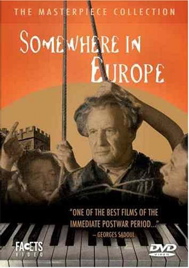| Release List | Reviews | Price Search | Shop | Newsletter | Forum | DVD Giveaways | Blu-Ray/ HD DVD | Advertise |
| Reviews & Columns |
|
Reviews DVD TV on DVD Blu-ray International DVDs Theatrical Reviews by Studio Video Games Features Collector Series DVDs Easter Egg Database Interviews DVD Talk TV DVD Talk Radio Feature Articles Columns Anime Talk DVD Savant HD Talk Horror DVDs Silent DVD
|
DVD Talk Forum |
|
|
| Resources |
|
DVD Price Search Customer Service #'s RCE Info Links |
|
Columns
|
 |
Somewhere in Europe
|
||||
This story of a gang of children running wild in the wake of WW2 plays like a forerunner of one of our morbid post-apocalyptic fantasies, crossed with a socialist version of Boys Town. Considering the downbeat subject matter, lawlessness on the back roads of 1945 Hungary must have been a serious problem, but the script by the famous critic, poet and screenwriter Béla Balázs assures us that the murdering hooligans are simply lost boys seeking a new direction. Somewhere in Europe is formulaic propaganda for a new socialist order, but it is still considered a key film of post-war Hungary.
The recurring image in Somewhere in Europe is a repeated shot of twenty ragged and dirty children moving along a road, searching for their next meal. The cast of characters is assembled in brief vignettes. A little blonde girl sees her father shot and a boy with glasses escapes from a death train. Our 'hero' Péter climbs from the bombed ruins of his reform school to celebrate the death of his warden. Unlike the Depression-era fugitives of Night of the Hunter these are rough kids with knives who know how to slaughter animals, and viewers should be forewarned that a pig and a horse are dispatched on camera. Béla Balázs' screenplay isn't very subtle with either its dramatics or its socialist message. Handbills are posted authorizing locals to shoot to kill when dealing with vandals. Reasserting social control from roaming cutthroats must have been as serious a national problem as the multitudes of displaced children and the film's basic plea combines the two into one issue: The state needs to pull these people back under state supervision and protection. German villainy is expressed mainly through graphic images of jackboots, menacing shadows and machine gun muzzles. A sadistic Hungarian policeman represents the present state of affairs; he puts on his old Nazi collaborationist uniform at night to remember good times. We never see the righteous saviors of the situation, presumably a nascent people's republic. The film instead gives us a Father Flanagan character in star Artúr Somlay's old man of music. Old Man Simon brings food and non-judgmental goodwill to the boys just as did Spencer Tracy. He lectures them on the higher ideal of Freedom by playing La Marseillaise on his piano, which is still in tune amid the castle's rubble. Rounding out the similarity to Boys Town is Kuksi (Ladislas Horváth) an adorable moppet designed for maximum audience appeal to audience. Kuksi is a scrapper who kicks a lot of kids in the pants before serving his function in the emotional finale. Sticking to a socialist agenda, Somewhere in Europe is careful to pitch its sentimentality at the communal level. Little Kuksi is not Old Man Simon's personal favorite; Péter leads because he's the biggest, not the most charismatic. As the group settles into Simon's castle the kids learn to stop fighting and behave for the good of the gang. One kid punished by being shut in a cabinet dutifully refuses to come out until given permission by Péter. That's clearly the correct socialist spirit! Péter and Éva become provisional guardians to the orphan wolf pack, and not parental substitutes. No "selfish" romance develops. The reform school boy shows an uncommon sensitivity to her story, which inadvertently becomes something of a perverse highlight. In a subjective flashback Éva is sexually victimized by a Nazi officer represented only by a menacing shadow. After the rape she exacts her revenge while partially disrobed. The erotic detail makes Somewhere in Europe a tame forerunner of sick Nazi holocaust sex fantasies like The Night Porter --- even Communists seem to know what will attract an audience. The conclusion is a grandstanding speech a plea for understanding by Old Man Simon. After all, he reasons, the wayward boys didn't start the war. Simon drops prophetic hints about a grand new justice-based government that will put things right, and bitter vigilantes like the unpopular police commissioner would do well to refrain from solving problems with mass executions. The movie ends with a promise of better days ahead, which must have seemed ironic to Hungarians aware of the political and ideological house-cleaning that followed the victory in Eastern Europe. Unhappy fates were meted out to equally sensitive and cultured Hungarians that didn't embrace totalitarian rule. Director Géza von Radványi appears to be schooled in Soviet-style montage. Early sequences are peppered with quick cuts of iconic statuary, and tilted camera angles heighten the photogenic appeal of smoldering ruins. A wax effigy of Adolf Hitler melts as a house of horrors burns, providing a crude expression of the end of Fascism. Somewhere in Europe is real propaganda that connected with Hungary's shell-shocked post-war public. Facets Video's DVD of Somewhere in Europe is an acceptable transfer of a mostly intact copy of the B&W film. Image contrast is mostly good and there's little evidence of frame damage after the opening reel. The audio is free of distortion, which favors Dénes Buday's rather bombastic symphonic score. As with most Facets releases, there are no extras.
On a scale of Excellent, Good, Fair, and Poor,
Somewhere in Europe rates:
Review Staff | About DVD Talk | Newsletter Subscribe | Join DVD Talk Forum |
|
| Release List | Reviews | Price Search | Shop | SUBSCRIBE | Forum | DVD Giveaways | Blu-Ray/ HD DVD | Advertise |






